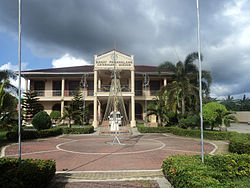Catanauan, Quezon
| Catanauan, Quezon | ||
|---|---|---|
| Municipality | ||

Catanauan Town Hall
|
||
|
||
| Nickname(s): Heart of the Bondoc Peninsula | ||
 Map of Quezon showing the location of Catanauan |
||
| Location within the Philippines | ||
| Coordinates: 13°35′30″N 122°19′30″E / 13.59167°N 122.32500°ECoordinates: 13°35′30″N 122°19′30″E / 13.59167°N 122.32500°E | ||
| Country | Philippines | |
| Region | CALABARZON (Region IV-A) | |
| Province | Quezon | |
| District | 3rd district of Quezon | |
| Founded | 1700 | |
| Barangays | 46 | |
| Government | ||
| • Mayor | Almira Abella-Orfanel (Lakas–CMD) | |
| Area | ||
| • Total | 253.07 km2 (97.71 sq mi) | |
| Population (2015) | ||
| • Total | 71,073 | |
| • Density | 280/km2 (730/sq mi) | |
| Demonym(s) | Catanauanin, "Ngani Baya" "Cocow" | |
| Time zone | PST (UTC+8) | |
| ZIP code | 4311 | |
| IDD : area code | +63 (0)42 | |
| Income class | 1st class; partially urban | |
The Municipality of Catanauan (Filipino: Bayan ng Catanauan) is a first class municipality in the province of Quezon, Philippines. According to the 2015 census, it has a population of 71,073 people.
The landscape of Catanauan is described as hilly, rolling and mountainous with isolated flat lands. The existing rivers and creeks serve as potential for effective drainage, more especially the Catanauan River. Catanuan has slopes ranging from 0-13% to 15% and above. The most elevated portion is at barangay San Jose which has slope of 60% and above. Susceptibility to erosion is directly proportional to the slope percentage and degree of susceptibility.
Catanauan being a first class municipality, boast of several commercial establishments including several restaurants, inns, and a major fast food chain, inns. One of the major agricultural trades by the populace is copra buying and selling. While infrastructure is sufficient, the public cemetery appears to be already at full capacity. Primary and Secondary level education is being catered by 1 public school and 1 private school. Tertiary education is being catered by the 2 colleges.
Catanauan is politically subdivided into 46 barangays.
The existence of Catanauan as a pueblo (town) was first recorded in the map of Father Pedro Murillo dated on 1734. The petitio dated 1685 of Bishop Andres Gonzales of Nueva Caceres, now known as Naga City in the Bicol Region, requesting the king of Spain to have Masbater and the Pueblo of Catanauan assigned to Recollect Order was reflective of the early creation of Catanauan. The recognized foundation year of the Municipality was 1713 called as Nabatasan.
In the late 18th and 19th century, there were frequent Moro raids. These occurrences prompted the people to construct two small stone forts or watch towers (magkatanawan) mounted with artillery. Santa Maria watch tower was located at Lot 21 psc-2 near the present wharf is located. Castillo watch tower stood at the intersection of present Rizal and Boncan Street. Hence, the name Catanauan was so derived.
December 8 - immaculate conception church town fiesta
“Boling-Boling” is an old age practice particular to Catanauanins, which is celebrated annually starting on the Sunday and ends on Tuesday preceding Ash Wednesday and signals the start of the Lenten Season. Participants roam around the town garbed in any costume they may fancy. Most of them wear colourful clown-like clothes while others imitate anybody whom they despise and make fun of them. It is the Pinoy version of carnival. No one can tell exactly when and how this practice started, not even the oldest resident of this town located at the heart of Bondoc Peninsula. Senior women wearing brightly coloured dresses and hats with flowers sing and dance from one house to another to solicit cash donations, half of which is given to the local Parish Church for its expenses during the Lenten Season activities and the other half for their own group’s civic projects. Boling-Boling comes from the Visayan word Boling, which means dirt. This reminds us that we are sinners and that we need to repent, do some spiritual cleansing and get ourselves ready for the Lenten Season. In earlier times, Catanauanins had a grandiose merry-making during the Boling-Boling as, starting the following day, which is Ash Wednesday, they will keep silent suspending all merry-makings until the Black Saturday in reverence to the Lenten Season. Some men skimpily clad in their undergarments put on mud or grease with charcoal all over their bodies and roam around the town trying to scare young women and children for fun.
...
Wikipedia


